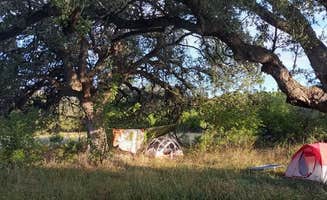Dispersed camping near Lakeway, Texas offers backcountry opportunities in the Hill Country terrain surrounding Lake Georgetown. The primitive sites experience temperature fluctuations typical of Central Texas, with summer highs often exceeding 95°F and winter overnight lows sometimes dropping below freezing. Spring and fall provide milder conditions for hikers accessing these remote locations, though seasonal storms can create muddy trail conditions.
What to do
Wildlife observation: The Lake Georgetown perimeter provides habitat for deer, armadillos, and numerous bird species. "We ended up not following our AllTrails after a fork in the road heading towards the campsite, and were pretty pooped so decided to camp there off Sawyer Campsite Rd. People had clearly used the shore as a campsite before as there was a makeshift fire pit and some cleared areas for tents. Water and views were beautiful," notes Alexandra from Sawyer Park Primitive Campsites.
Fishing access: Several dispersed sites offer direct lake access for anglers targeting bass and catfish. Bring compact fishing gear if hiking to these spots. The shoreline sites require proper licensing and adherence to Texas fishing regulations.
Trail running: The interconnected trail system provides varied terrain for runners seeking natural settings. The full loop offers marathon-distance training potential with multiple access points for shorter segments.
What campers like
Weekday solitude: Midweek visitors report significantly lower usage compared to weekends. "This is possibly the easiest campgrounds on the good water trail to get to which may result in there being more people at this site than others. This is the 'first come, first serve' campground," explains Guillermo L. from Walnut Springs Primitive Campground.
Water proximity: Many dispersed sites offer direct shoreline access. "We camped there off Sawyer Campsite Rd. People had clearly used the shore as a campsite before as there was a makeshift fire pit and some cleared areas for tents. Water and views were beautiful," reports a visitor to Sawyer Park.
Multi-activity options: The combination of hiking, swimming, and overnight camping creates versatile recreation possibilities. The trail's terrain varies between forest sections and open grasslands, providing diverse camping environments.
What you should know
Weather preparedness: Summer storms can develop quickly, requiring proper tent setup. "Enjoyed our stay during a thunderstorm under the big trees," notes a camper at Walnut Springs. "Rain started pretty heavily (and being close to the water probably didn't help with humidity inside the tent) and our rain fly was unwilling to cooperate so we got a bit wet," adds another camper about their San Gabriel River experience.
Limited navigation markers: Some trail junctions lack clear signage. One camper reported: "We ended up not following our AllTrails after a fork in the road heading towards the campsite." Carrying detailed maps or GPS is recommended, particularly for first-time visitors to these backcountry camping areas.
Access logistics: Plan your vehicle parking strategy carefully. "Upon entering one of the access points, park your car for free near the trailhead. It is good to advise one of the park attendants that you will be hiking or place a note inside your car that you are hiking," recommends Troy W. from San Gabriel River Trail.
Tips for camping with families
Distance planning: Consider children's hiking abilities when selecting sites. The Walnut Springs area can be accessed via a 2-mile hike from Russell Park, making it more manageable for families with younger children compared to the longer routes to other primitive sites.
Safety preparations: The combination of water proximity and remote location requires extra vigilance with children. Establish clear boundaries around camp and water areas upon arrival.
Educational opportunities: The diverse ecosystem provides natural learning experiences. Pack field guides for identifying local plants and wildlife found throughout the primitive camping areas near Lakeway.
Tips from RVers
Parking limitations: Standard RVs cannot access primitive camping areas. Vehicle camping is restricted to developed campgrounds only, with primitive sites requiring hiking access from designated parking areas.
Alternative considerations: RV campers seeking proximity to the primitive areas should consider Cedar Breaks Park or Jim Hogg Park as base camps, then day hike to explore the primitive sections of the San Gabriel River Trail system.


